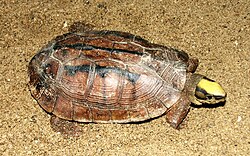Farming
C. trifasciata is raised on some of China's turtle farms. Based on the data from a large sample (almost one-half of all registered turtle farms in the country), researchers estimated that the turtle farmers participating in the survey had the total herd of 115,900 turtles of this species; they sold 20,600 turtles of this species per year, with the estimated value of almost US$37 million. This would make a farm-raised C. trifasciata worth almost $1,800, making them by far the most expensive species tabulated in the survey (by comparison, a common Pelodiscus sinensis raised for food would be worth under $7, and a Cuora mouhotii , sold for the pet trade, around $80). Taking into account the registered farms that did not respond to the survey, as well as the unregistered producers, the total numbers must be significantly higher. [11] Wild C. trifasciata turtles are far more valuable than farmed-raised turtles of this species to both traditional Chinese medicine practitioners and illegal wildlife traders. [12] [13] [14] The gender of C. trifasciata is determined by gestation temperatures. [10] [14] Due to incubation temperatures at farms in warm lowlands, farms have only been able to produce females. [10] [14] This increased the price of wild-caught males to $20,000. [10] [14] Most farmed C. trifasciata turtles are hybrids, which can escape and establish populations, causing genetic pollution. [13] [14] [15] [16]
The largest C. trifasciata farming operation is said to be located in Boluo County, Guangdong. According to the farm's founder Li Yi (李艺), the farm was started in 1989 with eight wild turtles (two males and six females) bought at a local market, and now has "over 2000" turtles. [17] According to the farm's site, captive-born turtles start breeding at 8 years of age. [18]
This page is based on this
Wikipedia article Text is available under the
CC BY-SA 4.0 license; additional terms may apply.
Images, videos and audio are available under their respective licenses.




